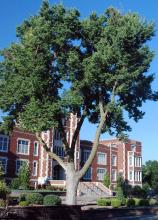Celtis occidentalis
Common name:
Common Hackberry
Pronunciation:
SEL-tis (KEL-tis) ok-si-den-TAH-lis
Family:
Ulmaceae
Genus:
Type:
Broadleaf
Native to (or naturalized in) Oregon:
No
- Deciduous tree, 40-60(90) ft [12-15(27) m] tall, similar spread, ascending arching branches, some drooping branches. Leaves simple, alternate (2 rows along twig), 6-9 cm long, ovate to oblong-ovate, long tapering tip, margin serrate except at base, dull light or medium green above, paler below (yellow or green yellow in fall), petiole 13-19 mm. Flowers greenish-yellow appear in spring as the foliage just begins to emerge, male (staminate), female (pistillate), and perfect flowers may be borne on a single tree. Fruit is berry-like drupe, reddish-purple, 6-8 mm across, persisting in winter, edible (flavor similar to dates).
- Sun, prefers rich, moist, soils but grows in dry, heavy or sandy soils. Withstands alkaline or acid soils, wind, heat and urban conditions.
- Leaves are often disfigured by nipple galls, which are wart-like projections about 4 mm in diameter and almost 6 mm high. They are caused by the psyllid insect Pachypsylla dismamma, one of many jumping plant lice. Blister galls, which are caused by Pachypsylla celtidisvesicula, are about 3-4 mm in diameter and only slightly raised above the leaf surface (Johnson and Lyon, 1991).
- Hardy to USDA Zone 3 Native from Quebec to Manitoba, south to North Carolina, Alabama, Georgia and Oklahoma.
- Hackberry: The "hack" apparently is a corruption of the Scottish "hag" (witch), however the "Hagberry" in Britain is the name given to sour bird cherries. The application of that name to Celtis occidentalis was possibly a result of the early colonists confusion with regard to the small cherry-like appearance of its fruit (Peattie, 1953, 1966).
- occidentalis: Latin meaning western (named by Linnaeus) in comparison with australis, southern. Celtis australis is native to southern Europe, northern Africa, and into southwestern Asia.











